 |
Acrosphaera murrayana (Haeckel) (Figure 15.19) [=Polysolenia murrayana].
Large pores, each surrounded by a crown of short spines.
Shell diameter: 70-180 µm. Ref: Strelkov and
Reshetnjak (1971),
Nigrini and Moore (1979). |
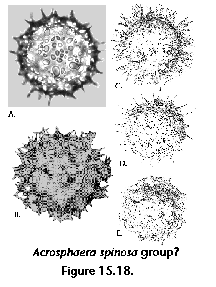 |
Acrosphaera spinosa (Haeckel) group? (Figure 1D, 15.18) [=Polysolenia spinosa,
?P. lappacea, ?P. flammabunda].
Irregular pores and many irregularly arranged spines
scattered about the surface, some of the latter extending
from the pore-rims. Spine and pore patterns are
variable. Shell diameter: 60-160 µm. Ref: Strelkov and
Reshetnjak (1971), Boltovskoy and
Riedel (1980). |
 |
Buccinosphaera invaginata Haeckel (Figure 15.17) [=Collosphaera imvaginata].
The smooth shell produces several pored tubes directed
toward the center of the sphere. Rather small, irregular
pores. Shell diameter: 100-130 µm. Ref: Strelkov and
Reshetnjak (1971), Nigrini (1971). |
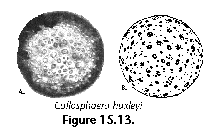 |
Collosphaera huxleyi Müller (Figure 1E, 15.13). Shells with small to medium-sized
pores scattered about the surface only; no spines or
tubes. Shell diameter: 80-150 µm. Ref: Strelkov and
Reshetnjak (1971), Boltovskoy and
Riedel (1980). |
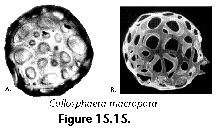 |
Collosphaera macropora Popofsky (Figure 15.15). No spines or tubes on shell
surface; few very large pores, sometimes angular. Shell
diameter: 100-120 µm. Ref: Strelkov and
Reshetnjak (1971), Boltovskoy and
Riedel (1980). |
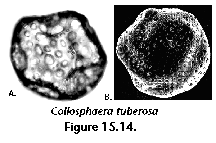 |
Collosphaera tuberosa Haeckel (Figure 15.14). No spines or tubes on shell
surface, but with conspicuous lumps and depressions; many
small, irregularly shaped pores. Shell diameter: 50-300
µm. Ref: Strelkov and
Reshetnjak (1971), Boltovskoy and
Riedel (1980). |
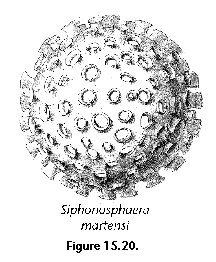 |
Siphonosphaera martensi Brandt (Figure 15.20). Each pore bears a short
centrifugal tube, tube walls are imperforate. Shell
diameter: 90-100 µm. Ref: Strelkov and
Reshetnjak (1971). |
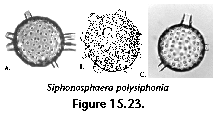 |
Siphonosphaera polysiphonia Haeckel (Figure 15.23) [=Siphonosphaera socialis,
?Siphonosphaera tenera]. Tubes of variable length
are present on some of the pores, tube walls are
imperforate. According to Strelkov and Reshetnjak
(1971) S. socialis Haeckel has usually smaller
shells (50-80 µm). Shell diameter: 80-120 µm. Ref: Nigrini and Moore
(1979), Boltovskoy and
Riedel (1980). |
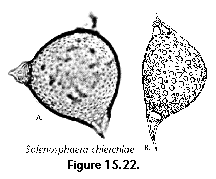 |
Solenosphaera chierchiae
Brandt (Figure 1C, 15.22) [=Otosphaera polymorpha].
The shell bears three-four (up to six) short tubes with
perforated walls whose distal end is tapered, ending in a
slanted pore provided with one-two conspicuous spines.
Shell diameter: 65-100 µm. Ref: Strelkov and
Reshetnjak (1971), Nigrini and Moore
(1979). |
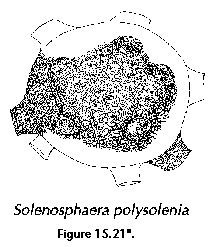 |
Solenosphaera polysolenia Strelkov and Reshetnjak (Figure 15.21). With many (rather than
three-five, as in Solenosphaera zanguebarica)
short tubes with perforated walls, and smaller, more
angular pores. Shell diameter: 90-280 µm. Ref: Strelkov and
Reshetnjak (1971). |
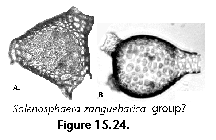 |
Solenosphaera zanguebarica (Ehrenberg) group? (Figure 15.24) [=Solenosphaera polymorpha,
Otosphaera polymorpha, Disolenia zanguebarica,
?Disolenia quadrata]. General outline of shell
often subtrianguar, the vertices extending into
three-four short tube-like protrusions with perforated
walls and open ends. The rim of these tubes may bear
spines. Pores irregular in shape and size, but generally
roundish or subangular. A morphotype very similar to S.
zanguebarica (and most probably conspecific with it),
usually cited as Disolenia quadrata (Ehrenberg)
(Figure 15.24a), differs by having somewhat larger tubes
which are better differentiated from the main body of the
shell. Shell diameter: 100-150 µm. Ref: Strelkov and
Reshetnjak (1971). |
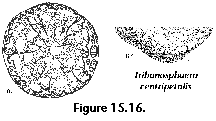 |
Tribonosphaera centripetalis Haeckel (Figure 15.16). Outer shell surface smooth, but
with many slender spines directed toward the center of
the sphere; pores irregular in size and shape. Shell
diameter: 100-120 µm. Ref: Strelkov and
Reshetnjak (1971), Boltovskoy and
Riedel (1980). |











